Subscribe to:
Post Comments (Atom)
Featured Post
Socratic Seminar - Community/Justice
Why do we feel the need to belong? How do we maintain our individual identities and be part of a community? What are the benefits and draw...

-
You can see the full graphic novel of The Odyssey and other works at TumbleBooks.com login information below ...
-
For my essential question, I decided to do it on the importance of valuing our parents and created a video. Typically, I would add a bunch...



No comments:
Post a Comment